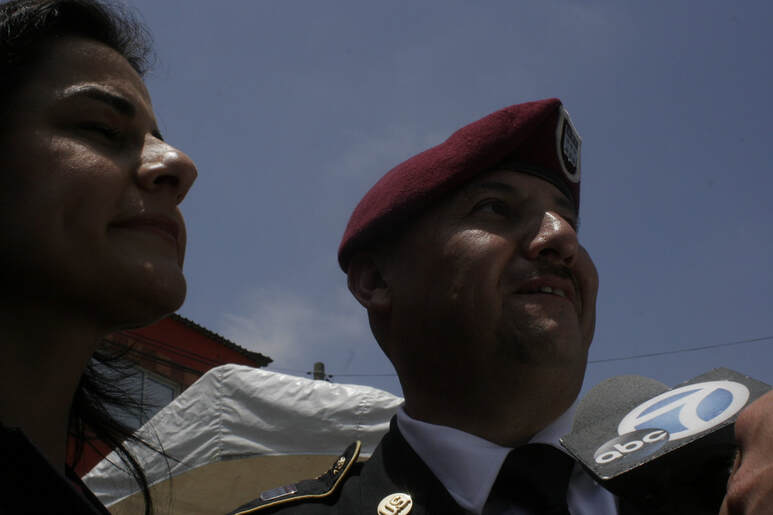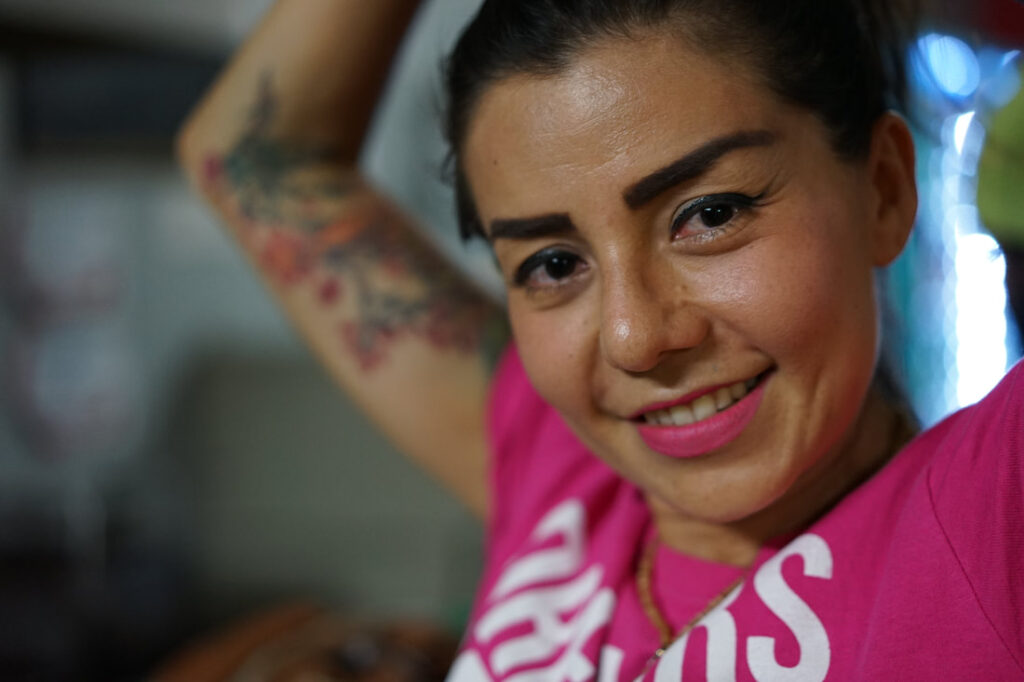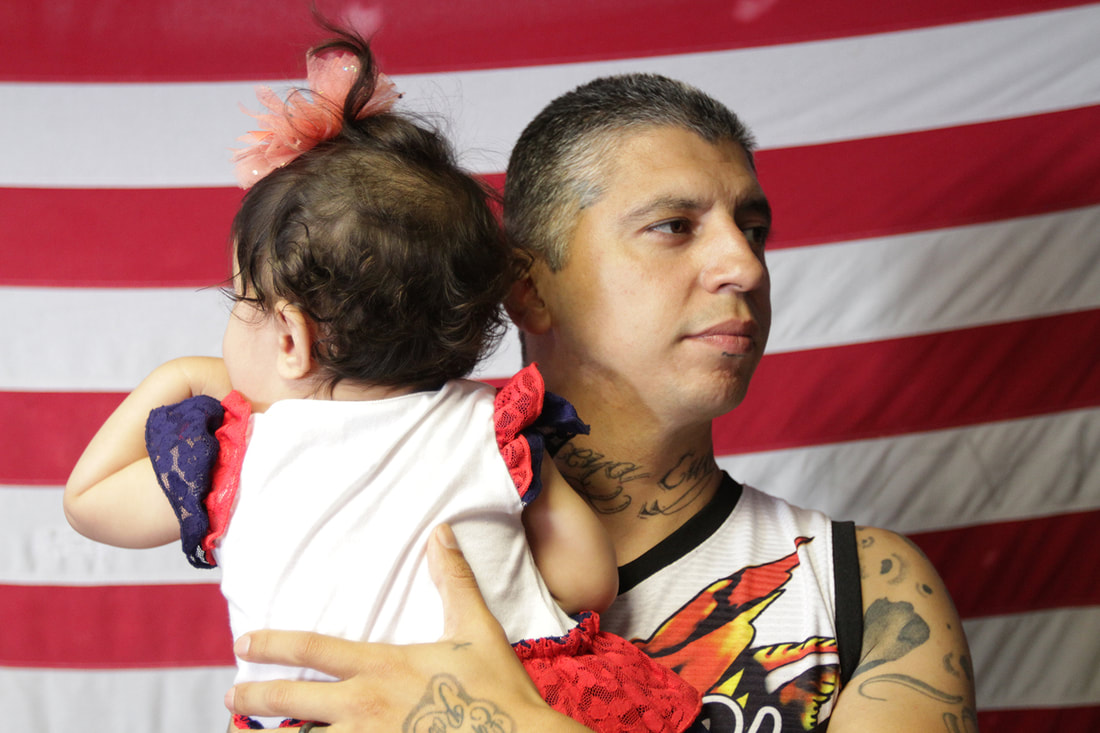Editor’s Note: According to some estimates the United States has deported some 94,000 military veterans, many for minor infractions committed after their service. A photography exhibit organized by the Tom and Ethel Bradley Center in Los Angeles, part of California State Northridge’s Journalism Department, highlights the experience of some of these veterans and their efforts to “reclaim their citizenship.” CSUN Journalism Professor José Luis Benavides directs the center and says the exhibit is an example of what it means to tell a story “from the inside,” about people and communities that are “usually not at the center.” He spoke to EMS Editor Peter Schurmann. (Image: Mauricio, deported US Army Afghanistan War combat veteran, with his daughter at the “Bunker,” the Deported Veteran Support House. Tijuana, Mexico, 2016.)
Tell us about the exhibit. What inspired it?
The seed was one of our colleagues, a professor and chair of the art department, Edward Alfano. He brought to my attention the work photographer Joseph Silva was doing with veterans. “You should pay attention to this,” he told me. The photos really struck me… they capture the humanity of these folks. But the photos also showed elements of their US citizenship. It could be the flag, the stuff they have around them. Like the photo of Hector Barajas’ boots, they’re a symbol of something larger. It was clear they were deported veterans. We at the Bradley Center are devoted to highlighting the images of people who are usually not at the center… minority or minoritized communities in general. And we look for photos that come from the inside. Because Joseph is a veteran, he is just hanging out with these veterans as he is capturing these moments.
What does the deportation of US veterans say about our broader immigration system?
They are the entry point into a story that has been neglected. A lot of the coverage about immigration focuses on people here, not on people who are deported. Once they are deported, no one cares about them. These veterans were willing to die for this country. Many of them were in war, they risked their lives and in doing so they became part of the fabric of this country. And yet by 1996 the Clinton Administration passes the Illegal Immigration Reform and Immigrant Responsibility Act, and all these minor offenses became justifications for deporting people. They should have been citizens. Once you get into the military, you have the ability to become a citizen, but many veterans didn’t know this at the time or were not informed. Many assumed they would automatically be granted citizenship.
There are some policy discussions now about supporting or bringing back deported veterans. How has that come about?
Hector Barajas is really the hero of this story. His activism in Tijuana is a testament to the work of the veterans who are advocating against this injustice. But there is another side to this issue. It’s not easy to come back after you’ve been deported. There are a lot of legal issues to settle before you can come back, and people don’t have assistance with these processes. And once these veterans come back, what are they going to do? They need assistance. I have heard stories… I remember an Ecuadorean veteran who was living in a shelter in South Los Angeles. Where is he going to live? He doesn’t have a job, his savings from Ecuador don’t go far here, and he doesn’t have a network. It is a complex issue.

Tell us more about the Bradley Center collection. What are some of the stories it tells? And why are they important?
We have a large collection of works by African American photographers, many of them working freelance for local black media. And that is because of Kent Kirkton (who founded what was then the Center for Photojournalism and Visual History as part of CSUN’s Department of Journalism in 1981. It was renamed the Tom and Ethel Bradley Center in 2015). He came up with the idea of archiving and collecting these works because no one was paying attention to them. There was a complete absence of black communities in the visual repertoire of Southern California. And that visual history disappears with these photographers unless someone pays attention. So, we’ve been trying to honor their work.
We have, for example, the visit by The Rev. Martin Luther King Jr. to Los Angeles in 1963 for the Freedom Rally. This is a pivotal year for the Civil Rights Movement. It’s the year of Birmingham, of high school students being attacked by Bull Connor’s dogs in Alabama. It’s the year of King’s Letter from Birmingham Jail. Everyone in the community was there at the rally, including Hollywood actors like Marlon Brando and Paul Newman. It was a happy, beautiful moment for the community as it engaged with the movement. The LA Times ran a story about the event, and the one photo they included was of a young man being taken away by police because he wanted to speak and tried to grab the mic. The paper also editorialized against MLK’s visit. In terms of visual history, that is a very distorted view of what was a really important moment for Los Angeles and the country.

It’s a fraught time for the country, socially, politically, economically. How do you see the role of the Bradley Center in this moment?
The nature of what we do, the mission of the Bradley Center is about empowering people. All the topics we’re discussing, the African American photographers, the work of Joseph and the veterans he’s photographed. These are testaments to the activism of those who see injustice happening and their work to fix it. We have a new grant from the National Endowment for the Humanities focusing on the farm worker’s movement. We’re featuring two photographers: Emmon Clarke, who volunteered as a photographer with the United Farm Workers Association in 1966; and John Kouns, who photographed the Civil Rights and United Farm Workers movements. These are amazing historical documents that bring that visibility to these struggles. And I am hoping they inspire younger people to learn from these struggles, that they can be part of a larger movement toward something better.
The exhibition, “Deported Veterans: Photographs by Joseph Silva,” is open to the public at the Museum of Social Justice, located at 115 Paseo de La Plaza, Los Angeles.







